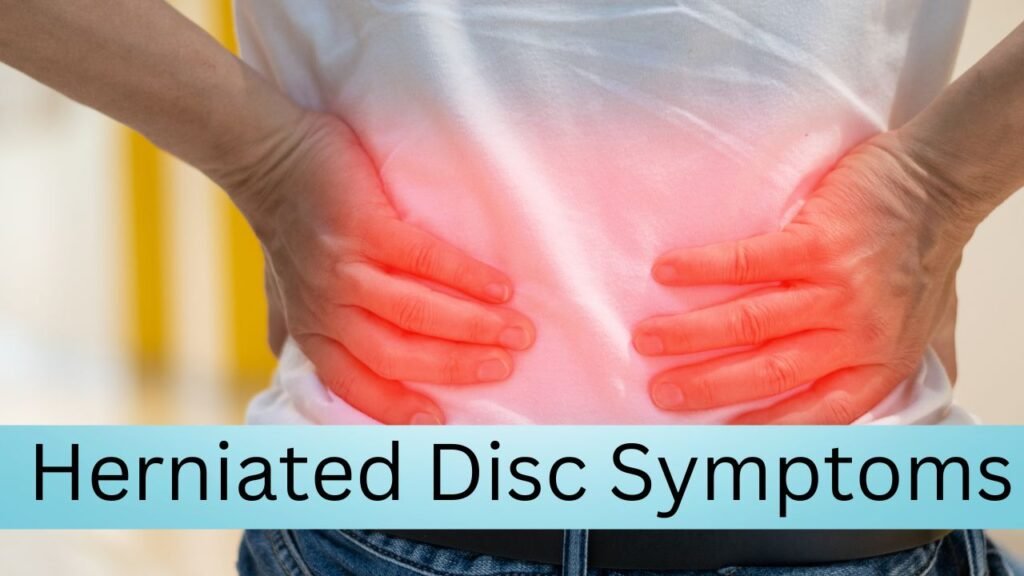A herniated disc is a common spinal condition that can cause significant discomfort and mobility issues. When the soft inner gel of a spinal disc pushes through its outer layer, it can press on nearby nerves, leading to pain, numbness, and weakness. Understanding the symptoms and treatment options can help manage this condition effectively.

Understanding a Herniated Disc
The spine consists of vertebrae separated by discs that act as cushions. These discs have a tough outer layer and a soft inner core. When the outer layer weakens or tears, the inner material can protrude, resulting in a herniated disc. This condition is most common in the lower back (lumbar spine) but can also occur in the neck (cervical spine).
Common Symptoms of a Herniated Disc
The symptoms of a herniated disc depend on its location and the nerves it affects. Here are the most common signs:
1. Pain in the Affected Area
- A herniated disc in the lower back often causes pain in the lower spine, buttocks, and legs (sciatica).
- A herniated disc in the neck may lead to pain in the shoulders, arms, and hands.
2. Numbness and Tingling
- Pressure on spinal nerves can cause a tingling sensation in the legs, feet, arms, or hands.
- Numbness may occur in areas served by the affected nerve.
3. Muscle Weakness
- A compressed nerve can weaken muscles, making it difficult to lift objects, grip firmly, or walk properly.
- Muscle atrophy may develop over time if the condition is left untreated.
4. Sharp or Radiating Pain
- The pain may extend from the spine down to the legs or arms.
- Sciatica, a common symptom of lumbar disc herniation, causes shooting pain down one side of the body.
5. Worsening Pain with Movement
- Certain activities, such as bending, lifting, or twisting, can aggravate the pain.
- Prolonged sitting or standing may also increase discomfort.
Causes and Risk Factors
Several factors contribute to disc herniation, including:
- Age: Discs lose water content over time, making them more prone to tearing.
- Repetitive Movements: Frequent lifting, bending, or twisting can strain the spine.
- Injury: Sudden trauma, such as a fall or accident, can cause disc damage.
- Genetics: Some people are predisposed to disc degeneration.
- Obesity: Excess weight puts added stress on the spine.
- Sedentary Lifestyle: Weak core muscles provide less support to the spine.
Diagnosing a Herniated Disc
A doctor will conduct a physical examination and assess symptoms to diagnose a herniated disc. Common diagnostic methods include:
- Physical Tests: Checking muscle strength, reflexes, and range of motion.
- MRI or CT Scan: Imaging tests provide a detailed view of the spine.
- X-rays: While X-rays don’t show herniated discs, they help rule out other spinal issues.
- Nerve Tests: Electromyography (EMG) measures nerve function and identifies compression.
Effective Treatments for a Herniated Disc
1. Rest and Activity Modification
- Avoid heavy lifting, prolonged sitting, or sudden movements.
- Engage in gentle movements to prevent stiffness and maintain mobility.
2. Pain Management
- Over-the-counter medications like ibuprofen or naproxen reduce inflammation.
- Prescription muscle relaxants or corticosteroid injections may be recommended for severe pain.
3. Physical Therapy
- Strengthening core and back muscles can improve spinal support.
- Stretching exercises relieve tension and promote flexibility.
- Therapists may use techniques such as ultrasound or electrical stimulation.
4. Heat and Cold Therapy
- Applying heat relaxes muscles and improves circulation.
- Ice packs reduce swelling and numb pain.
5. Chiropractic Care
- Spinal adjustments may relieve pressure on affected nerves.
- Not all cases are suitable for chiropractic treatment, so consult a professional.
6. Epidural Steroid Injections
- Injections of corticosteroids into the spine can provide temporary relief.
- This option is usually recommended when conservative treatments are ineffective.
7. Surgery (As a Last Resort)
- Surgery is considered only if symptoms persist despite treatment.
- Common procedures include microdiscectomy (removal of the herniated portion) or spinal fusion.
- Recovery time varies, but many patients experience significant pain relief post-surgery.
Best Exercises for Herniated Disc Relief
1. Pelvic Tilts
- Strengthens the lower back and core muscles.
- Lie on your back with knees bent, tighten your stomach muscles, and press your lower back into the floor.
2. Knee-to-Chest Stretch
- Relieves tension in the lower back.
- Lie on your back, pull one knee toward your chest, and hold for 20-30 seconds.
3. Cat-Cow Stretch
- Improves spinal flexibility and reduces stiffness.
- Start on all fours, arch your back upward, then lower it into a gentle curve.
4. Seated Spinal Twist
- Increases mobility and relieves spinal pressure.
- Sit with legs extended, bend one knee, place the opposite arm across the knee, and gently twist.
5. Partial Crunches
- Strengthens the core without straining the back.
- Lie on your back with knees bent, lift your shoulders slightly, and hold briefly before lowering.
Preventing a Herniated Disc
Prevention is key to maintaining spinal health. Follow these strategies:
- Maintain Good Posture: Sit and stand with a straight back to reduce strain.
- Exercise Regularly: Strengthen core muscles to support the spine.
- Lift Properly: Bend at the knees and avoid twisting while lifting heavy objects.
- Stay Active: Avoid prolonged sitting or standing; take breaks to stretch.
- Maintain a Healthy Weight: Excess weight increases pressure on spinal discs.
When to Seek Medical Help
See a doctor if:
- Pain lasts more than a few weeks or worsens.
- Numbness, weakness, or difficulty walking develops.
- Loss of bladder or bowel control occurs (a medical emergency).
Final Thoughts
A herniated disc can be painful, but with proper treatment, most people recover without surgery. Identifying symptoms early and using effective treatments can prevent long-term complications. Staying active, practicing good posture, and strengthening the spine are essential for preventing future disc issues. If symptoms persist, seek medical guidance for a tailored treatment plan.